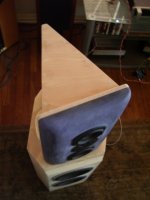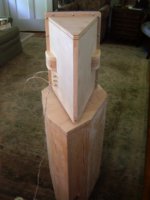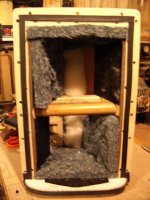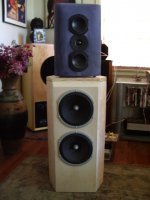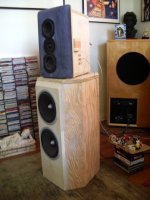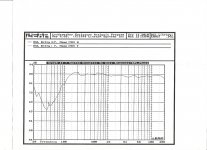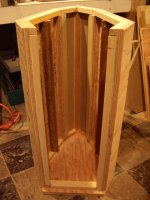A question to resurrect this thread:
I have seen the B&W Nautilus enclosure drawing many times, as shown earlier in this thread, but I am not able to determine if the midrange enclosure is open at the rear end of the tapered tube. I am trying to emulate that enclosure style with a longish, narrow isosceles triangle instead of the tapered tube.
Even with the enclosure walls well damped and the whole thing filled with long fiber wool, I seem to be getting a lot of boxy colorations in the lower midrange. Should I cut off the very point of the triangle, making a narrow slot opening at the rear of the enclosure?
I would appreciate your opinions.
Peace,
Tom E
I have seen the B&W Nautilus enclosure drawing many times, as shown earlier in this thread, but I am not able to determine if the midrange enclosure is open at the rear end of the tapered tube. I am trying to emulate that enclosure style with a longish, narrow isosceles triangle instead of the tapered tube.
Even with the enclosure walls well damped and the whole thing filled with long fiber wool, I seem to be getting a lot of boxy colorations in the lower midrange. Should I cut off the very point of the triangle, making a narrow slot opening at the rear of the enclosure?
I would appreciate your opinions.
Peace,
Tom E
Attachments
Can you open the midrange box easily?
I would be more inclined ( gut feeling only ) to square off the inside back panel and use some dense fibreglass in addition to the wool rather than make the box aperiodic Are you using passive XO?
I can open the box quite easily; I've already done it a dozen or more times! I've played with stuffing density and type. Right now, sides, top, and apex are lined with cotton insulation (better at absorbing midrange than fiberglass), plus some thick felt in a few places, then stuffed with varying density of wool (thicker toward the rear). The whole point of the enclosure shape is to avoid a flat, reflective back panel. Thanks for your gut feeling, but why would I want to make it flat? Is the inside of the enclosure acting like a horn?
Crossover is active between bass bins and top, carefully built by me with quality components and many trial alignments but no measurements because I lack the equipment. Passive xover between mids and tweeter, professionally designed. The active portion could be part of or the entire problem, but what I'm hearing sounds like box coloration: a sort of echoey, hollow sound. Upper mids and highs are sweet, detailed, open.
Internal pic, obviously without wool.
Peace,
Tom E
Attachments
Last edited:
I'd open the slot at the back since it could be plugged or damped if needed. Lower midrange colorations can come from room effects also of course. Nice build.
Yes, it could be closed again with only mild difficulty. My room is certainly not perfect, but I've had other speakers in there (B&W 802's) that sounded pretty darn nice. Actually, the highs, upper mids, and bass of these speakers sounds better than the B&W's did. It's just the lower vocals and low strings that sound somewhat echoey and recessed. Maybe I'm expecting too much, but after all the effort and expense of building these (thanks for noticing), I would like to improve this one weak spot in the spectrum. I have built other speakers with better performance in the low mids, so I know it can be done. These are good Peerless drivers, so I know they have the capability to sound better.
Here is another pic, with subwoofer in the background.
Peace,
Tom E
Attachments
Last edited:
The passive between mids and tweeter is around 2800, approximately 2nd order, acoustic. The active beteen bass and mids is LR4 @ 220 LP and Butterworth 2nd order @ 300 HP, electrical. Response curve of mids/tweets shown below.
Woofers are Peerless 830884 8". Bass bin enclosure volume is two cubic feet, lined with thick felt and pretty well stuffed with fiberglass. I do not have a response curve. Pic of internal bass bin, without any filling, shown below. There is another layer of 1/2" plywood applied over the internal 3/4" layer shown. The bottom of the enclosure is covered with a tapered (sloped from thin at front to thick at the apex) 1-1/2" thick layer of VERY rough texture concrete.
Peace,
Tom E
Woofers are Peerless 830884 8". Bass bin enclosure volume is two cubic feet, lined with thick felt and pretty well stuffed with fiberglass. I do not have a response curve. Pic of internal bass bin, without any filling, shown below. There is another layer of 1/2" plywood applied over the internal 3/4" layer shown. The bottom of the enclosure is covered with a tapered (sloped from thin at front to thick at the apex) 1-1/2" thick layer of VERY rough texture concrete.
Peace,
Tom E
Attachments
Last edited:
I am not able to determine if the midrange enclosure is open at the rear end of the tapered tube.
I've only been up close to the original and all the tubes are closed to mimic a plane wave tube's response.
GM
I've only been up close to the original and all the tubes are closed to mimic a plane wave tube's response.
GM
Need you to elaborate just a bit, if you would, please.
Original as in the huge Nautilus original thingy built like a snail's shell (They couldn't very well call it "The Snail", could they?), or a B&W commercial product such as the 801 or 802?
What is a plane wave tube response? Do you mean plain?
Peace,
Tom E
Very nice build by the way.
What active XO are you using, home built or off the shelf?
Thanks very much.
I bought ESP PCB's and built them myself. Built, then rebuilt, then rebuilt again. Trial and error active xover design is a real pain. Parts quality is very high and I've gotten really good at soldering, so the execution is not at fault. I wish I knew for sure what I should be building.
I also wish someone rented loudspeaker design and measuring equipment. Madisound designed the passive portion (even included an optional configuration for me to try), which seems to work very well, but they didn't seem at all interested in helping with the active stuff. Different format for them, so not their strong point, perhaps.
I don't understand why you think an enclosure with a flat panel back would be less reflective than mine. Or do you mean I should try fiberglass instead of wool and cotton? Actually, I did have fiberglass in them at one time. The cotton is better at absorbing midrange, and B&W uses wool so I figure it must be pretty good.
Peace,
Tom E
The original with the spiral woofer terminated tube. No, 'plane' wave tube [AKA standing wave tube]. It's a tube used to measure drivers, microphones or similar. The end is terminated to mimic a true infinite baffle, i.e. no reflections back to the driver to modulate it.
My fave was this sixteen large format horn driver tester I got to 'experience' during a tour of Altec: http://www.audioheritage.org/vbulletin/attachment.php?attachmentid=51694&stc=1&d=1308238768
GM
My fave was this sixteen large format horn driver tester I got to 'experience' during a tour of Altec: http://www.audioheritage.org/vbulletin/attachment.php?attachmentid=51694&stc=1&d=1308238768
GM
Tom ... does altering the xo point change the response? ... have you tried this up or down?The active beteen bass and mids is LR4 @ 220 LP and Butterworth 2nd order @ 300 HP, electrical.
Peace,
Tom E
Actually I was thinking that the sum of the reflections was aimed back at the face of the mid driver and that dense fibreglass stuffing was the best way around this
No, the cab will have a very diffuse reflection field with only the vertical seam and the parallel top, bottom surfaces causing eigenmodes back to the drivers, so in the scheme of things only the top, one side and seam need damping.
GM
The lowest standing wave is going to be half wavelength the height of your cabs. What is the height of your cabs?
For the cost of two or maybe one boutique cap, invest in a dayton emm6 and a phantom supply for it. And learn how to measure! It's not that hard.
Dayton Audio EMM-6 Electret Measurement Microphone Allows For Accurate Acoustic Measurements At A Fraction Of The Price 390-801
M-Audio Audio Buddy 2-Channel Preamp | Musician's Friend
Also MiniDSP or np's b4 active crossover is a much better solution that what you have done with the boards. The boards would be fine if you knew the final slopes, they are not that great for prototyping.
For the cost of two or maybe one boutique cap, invest in a dayton emm6 and a phantom supply for it. And learn how to measure! It's not that hard.
Dayton Audio EMM-6 Electret Measurement Microphone Allows For Accurate Acoustic Measurements At A Fraction Of The Price 390-801
M-Audio Audio Buddy 2-Channel Preamp | Musician's Friend
Also MiniDSP or np's b4 active crossover is a much better solution that what you have done with the boards. The boards would be fine if you knew the final slopes, they are not that great for prototyping.
Even with the enclosure walls well damped and the whole thing filled with long fiber wool, I seem to be getting a lot of boxy colorations in the lower midrange. Should I cut off the very point of the triangle, making a narrow slot opening at the rear of the enclosure?
Based on the pics, I'm going to guess that your plywood/concrete bass unit is ringing quite a bit in the lower midrange. Ply is amazing for true subs but IMHO should be used with some sort of damping material on it, like dynamat or the coating equivalent.
Member
Joined 2003
For the cost of two or maybe one boutique cap, invest in a dayton emm6 and a phantom supply for it. And learn how to measure! It's not that hard.
+1
....plywood/concrete bass unit is ringing quite a bit in the lower midrange.
Hmm, missed the attached concrete base, so yes, this lowers the cab's Fs considerably, probably down into the cab's gain BW, which most likely is causing the 'hollow' sound and probably will require more damping than there's room in the cab for.
If something heavy is to be used to mass load the cab, it should be on top, so with concrete on the bottom you'll probably have to add a significant amount of temporary weight to see if it helps enough.
GM
A question to resurrect this thread:
I have seen the B&W Nautilus enclosure drawing many times, as shown earlier in this thread, but I am not able to determine if the midrange enclosure is open at the rear end of the tapered tube. I am trying to emulate that enclosure style with a longish, narrow isosceles triangle instead of the tapered tube.
Even with the enclosure walls well damped and the whole thing filled with long fiber wool, I seem to be getting a lot of boxy colorations in the lower midrange. Should I cut off the very point of the triangle, making a narrow slot opening at the rear of the enclosure?
I would appreciate your opinions.
Peace,
Tom E
Nothing wrong with the cabinet shape but don't assume that it absorbs reflections. The absorbing material is still crucial to what amount of back wave gets absorbed.
This is tied to the angle of the back V. If you have two back faces at 45 and 45 then with 2 bounces the wave will come straight back to the front. With the angle you show it would take 3 bounces to get back to the front. With a single back surface it takes one bounce.
So if you absorption material is very poor then you get a few more chances for it to get absorbed and should see a small improvement over the same material and a flat back. Still it is the absorbing material that does the job.
The whole discussion of slot at the back seems to center on some thought that the sound funnels down and then sneaks out the slot with no reflections. If you assume specular reflections (bouncing like light rays off of a mirror), very little would make it to the slot, most would reflect across the surfaces and reverse direction without hitting it. If any sound does hit the slot, it still reflects back, but out of phase rather than in phase.
No magic bullets here.
David
- Status
- This old topic is closed. If you want to reopen this topic, contact a moderator using the "Report Post" button.
- Home
- Loudspeakers
- Multi-Way
- Best sealed enclosure for completely supressing back wave
